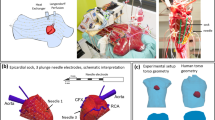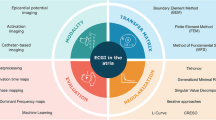Abstract
Non-invasive imaging of cardiac electrophysiology provides a non-invasive way of obtaining information about electrical excitation. An iterative algorithm based on a general regularisation scheme for non-linear, ill-posed problems in Hilbert scales was applied to the electrocardiographic inverse problem, imaging the ventricular surface activation time (AT) map. This method was applied to electrocardiographic data from a 31-year-old healthy volunteer and a 24-year-old patient suffering from a Wolff-Parkinson-White (WPW) syndrome. The objective was to evaluate non-invasive AT imaging of an autonomous sinus rhythm and to quantify the localisation error of non-invasive AT imaging by localising the accessory pathway of the WPW syndrome and a pacing site for left ventricle pacing. The distances between the invasive and non-invasive localisation of the pacing site and the accessory pathway were 8mm and 5mm. The clinical case presented, shows that this non-invasive AT imaging approach may enable the reconstruction of single focal events with sufficient accuracy for potential clinical application.
Similar content being viewed by others
References
Ben Haim, S. A., Osadchy, D., Schuster, I., Gepstein, L., Hayam, G., Josephson, E. (1996): ‘Nonfluoroscopic,in vivo navigation and mapping technology’,Nat. Med.,2, pp. 1393–1395
Cuppen, J., andvan Oosterom, A. (1984): ‘Model studies with inversely calculated isochrones of ventricular depolarization’,IEEE Trans. Biomed. Eng.,31, pp. 652–659
Durrer, D., van Dam, R., Freud, G., Janse, M., Meijler, F., andArzbaecher, R. (1970): ‘Total excitation of the isolated human heart’,Circulation,41, pp. 899–912
Fischer, G., Tilg, B., Wach, P., Modre, R., Leder, U., andNowak, H. (1999): ‘Application of high-order boundary elements to the electrocardiographic inverse problem’,Comput. Meth. Prog. Biomed.,58, pp. 119–131
Fischer, G., Tilg, B., Modre, R., Huiskamp, G. J. M., Fetzer, J., Rucker, W., andWach, P. (2000): ‘A bidomain model based BEM-FEM formulation for anisotropic cardiac tissue’,Ann. Biomed. Eng.,28, pp. 1229–1243
Greensite, F. (1994): ‘The mathematical basis for imaging cardiac electrical function’,Crit. Rev. Biomed. Eng.,22, pp. 347–399
Hansen, P. C. (1998): ‘Rank-deficient and discrete ill-posed problems’, (Siam, Philadelphia, 1998)
Huiskamp, G., andGreensite, F. (1997): ‘A new method for myocardial activation imaging’,IEEE Trans. Biomed. Eng.,44, pp. 433–446
Modre, R., Tilg, B., Fischer, G., Hanser, F., andMessnarz, B. (2002a): ‘Influence of cardiac electrical anisotropy on activation time imaging’. Proc. 13th Int. Conf. on Biomagnetism BIOMAG2002, pp. 830–832
Modre, R., Tilg, B., Fischer, G., andWach, P. (2002b): ‘Non-invasive myocardial activation time imaging: A novel inverse algorithm applied to clinical ECG mapping data’,IEEE Trans. Biomed. Eng.,49, pp. 1153–1161
Modre, R., Tilg, B., Fischer, G., Hanser, F., Messnarz, B., Seger, M., Schocke, M. F. H., Berger, T., Hintringer, F., andRoithinger, F. X. (2003): ‘Atrial noninvasive activation mapping of paced rhythm data’,J. Cardiovasc. Electrophysiol.,14, pp. 1–8
Ostendorp, T. F., andPesola, K. (1998): ‘Non-invasive determination of the activation sequence of the heart: Validation by comparison with invasive human data’,Comput. Cardiol.,25, pp. 313–316
Oster, H. S., Taccardi, B., Lux, R. L., Ershler, P. R., andRudy, Y. (1997): ‘Noninvasive electrocardiographic imaging: reconstruction of epicardial potentials, electrograms, and isochrones and localization of single and multiple electrocardiac events’,Circulation,96, pp. 1012–1024
Oster, H. S., Taccardi, B., Lux, R. L., Ershler, P. R., andRudy, Y. (1998): ‘Electrocardiographic imaging. Noninvasive characterization of intramural myocardial activation from inversereconstructed epicardial potentials and electrograms’,Circulation,97, pp. 1496–1507
SippensGroenewegen, A., Peeters, H. A. P., Jessurun, E. R., Linnenbank, A. C., Robles de Medina, E. O., Lesh, M. D., andvan Hemmel, N. M. (1998): ‘Body surface mapping during pacing at multiple sites in the human atrium’,Circulation,97, pp. 369–380
Smeets, J. L., Ben-Haim, S. A., Rodriguez, L. M., Timmermans, C., andWellens, H. J. (1998): ‘New method for nonfluoroscopic endocardial mapping in humans—accuracy assessment and first clinical result’,Circulation,97, pp. 2426–2432
Tilg, B., SippensGroenewegen, A., Fischer, G., Modre, R., Mlynash, M., Wach, P., Lesh, M., andSteiner, P. (2000): ‘Noninvasive imaging of the endocardial and epicardial activation time map—a validation study in humans’. Proceedings NASPE 2000, Washington, DC,Pace,23, p. 542
Tilg, B., Fischer, G., Modre, R., Hanser, F., Messnarz, B., Schocke, M., Kremser, C., Berger, T., Hintringer, F., andRoithinger, F. X. (2002a): ‘Model-based imaging of cardiac electrical excitation in humans’,IEEE Trans. Med. Imag.,21, pp. 1031–1039
Tilg, B., Hanser, F., Modre, R., Fischer, G., Messnarz, B., Berger, T., Hintringer, F., Pachinger, O., andRoithinger, F. X. (2002b): ‘Clinical ECG mapping and imaging of cardiac electrical excitation’,J. Electrocardiol.,35, pp. 81–87
Yamashita, Y., andGeselowitz, D. (1985): ‘Source-field relationships for cardiac generators on the heart surface based on their transfer coefficients’,IEEE Trans. Biomed. Eng.,32, pp. 964–970
Author information
Authors and Affiliations
Corresponding author
Rights and permissions
About this article
Cite this article
Modre, R., Tilg, B., Fischer, G. et al. Ventricular surface activation time imaging from electrocardiogram mapping data. Med. Biol. Eng. Comput. 42, 146–150 (2004). https://doi.org/10.1007/BF02344624
Received:
Accepted:
Issue Date:
DOI: https://doi.org/10.1007/BF02344624




